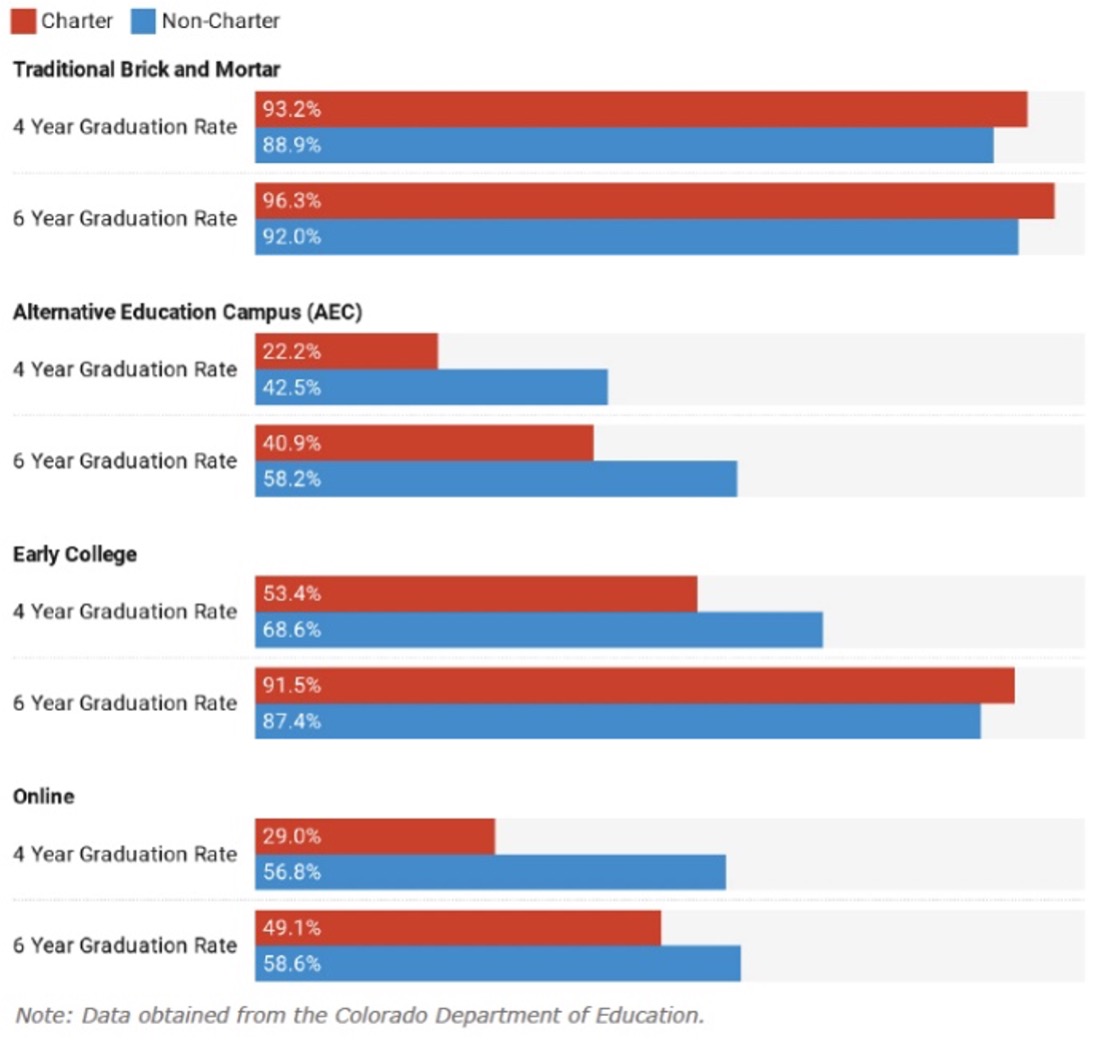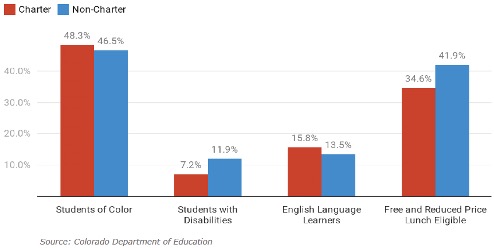Author: Kelly Caufield, Jimena Sanchez
Introduction
According to the Colorado Department of Education (CDE), The CDE mentioned that “if all charter schools were organized within a single district, it would be the largest school district in the state,” exemplifying the vast presence of charter schools in Colorado[ii]
Background on HB24-1363
House Bill HB24-1363, Charter Schools Accountability, was recently introduced to the Colorado legislature and is now under consideration in the House Education Committee.[iii] This bill is sponsored by Rep. Lorena García (D-35), Rep. Tammy Story (D-25), and Sen. Lisa Cutter (D-20). This bill would impose strict financial and administrative measures on the establishment and renewal of charter schools throughout the state.
The legislation would repeal the ability of a district charter school or charter school applicant to apply to use vacant or underused district buildings or land. Charter schools would also be required to pay rent for school district facilities.
There would also be stricter regulations concerning the charter school’s governing body since at least one-third of the body would need to be comprised of parents or legal guardians of students enrolled in the charter schools that accurately reflect the community demographics of the school location.
The local board would also be armed with the power to revoke or not renew a charter application due to the school district or district charter school’s declining pupil enrollment. Not only would the local board play a deciding role, but the community would also be given power since they would be able to appeal a local board’s decision to approve a charter application if the bill is passed.
Charter schools would also need to publicize more data about how effective they are in the communities in which they operate. Charter school applications or renewals would be required to provide information that their educational services meet the unmet needs of the community where the school resides. Also, charter schools would need to disclose information regarding laws and policies waived by the charter school, unredacted federal form 990, and an unredacted copy of any form, including revenue and expense related to marketing and student recruitment.
Charter Schools Surpass Public Schools’ Proficiency Rates
According to a report written by Jason Gaulden, the Common Sense Institute Education Fellow, statewide and Colorado Springs area education data prove that district charter schools consistently outperform district-operated schools on the state School Performance Framework.[iv] For example, in 2022, 85% of students attending district charter schools earned a “performance” rating on the School Performance Framework, which is the highest of four proficiencyearned a performance rating. This 19% difference highlights the positive effects that charter schools have on the overall status of student proficiency rates.
Diving deeper into the statewide data in 2022, according to an analysis from the Keystone Policy Center, 37% of charter students met or exceeded grade-level expectations in English Language Arts compared to 31% of third through eighth graders in district-run schools.[v] Moreover, on the math test, 31% of students met or exceeded grade-level expectations compared to 27% in district-managed schools.
In Colorado Springs District 11, 54.4% of charter students in the eighth grade met or exceeded grade-level expectations in English Language Arts compared to 35.9% of eighth graders in district-run schools. Regarding the math assessment for third graders, 47% of students met or exceeded grade-level expectations compared to 35.7% in district-managed schools.
Charter School Graduation Rates Compared to Traditional Public Schools

In 2020, a CSI report by Dr. Brenda Bautsch Dickhoner, the former CSI Education Fellow, contained critical data on Colorado Charter schools.[vi] The graduation data presented in this report highlights slight to considerable differences between charter and non-charter schools. For example, the 29 charter schools authorized by school districts in the Metro area have graduation rates two to three percentage points higher than those of the 91 non-charter schools in the area. Most notably, the four-year graduation rate for brick-and-mortar charter schools was 93.2%in 2019 compared with 88.9%at brick-and-mortar non-charter high schools.
Enrollment in Charter and Non-Charter Schools by Student Characteristics, 2018-19

Charter Schools and Academic Performance
The 2020 CSI report also cited a 2019 CREDO study focusing on students’ academic performance in public K-12 schools in Denver, Colorado.[vii] The study analyzed the one-year learning growth of students in charter schools and traditional public schools. The found that the academic growth experienced by low-income Black students in charter schools equaled 59 days of additional learning in math and 44 days of additional learning in reading, as compared to their peers in non-charter schools.  Hispanic students in poverty also had significant gains equivalent to 48 days of additional math learning and 25 days of additional reading learning compared to their peers in district-run schools.
Performance-wise, CREDO also found that Black students attending charter schools saw more robust growth in reading than their peers in district-run schools. Meanwhile, graduation data shows that the four-year and six-year graduation rates for Black and African American students are 5.7 percentage points higher than the respective graduation rates for their peers at district-run schools.
These differences are noted both for students overall and for disaggregated groups of students, such as students of color, low-income students, English Language Learners, and students with disabilities. CDE also notes that charter schools, on most metrics, have smaller achievement gaps between subgroups of students, for example, between students who qualify for free and reduced lunch (FRL) and those who do not.
Conclusion
Based on the data, charter schools have a significant ability to increase proficiency rates and graduation rates in Colorado. Charter schools have also demonstrated and continue to show their commitment to closing achievement gaps between students, especially for disadvantaged students. A policy that allows for expansion and replication, not a policy that limits this education model, is likely to lead to stronger academic outcomes for Colorado students.
[i] https://www.cde.state.co.us/cdechart/faq
[ii] https://www.cde.state.co.us/cdedepcom/2019charterschoolsreport
[iii] https://leg.colorado.gov/sites/default/files/documents/2024A/bills/2024a_1363_01.pdf
[iv] https://commonsenseinstituteco.org/colorado-springs-education-funding/
[v] https://www.keystone.org/wp-content/uploads/2022/11/KPC-014-REPORT_CharterSchoolPerformance-2022_r4_singles.pdf
[vi] https://commonsenseinstituteco.org/data-co-charter-schools/
[vii] https://credo.stanford.edu/reports/item/denver/
[viii] https://www.cde.state.co.us/cdedepcom/2019charterschoolsreport
[ix] https://www.cde.state.co.us/cdedepcom/2019charterschoolsreport

